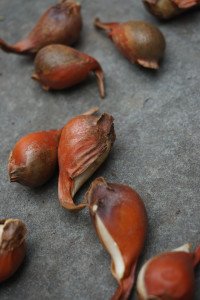It’s been a beautiful Fall — the weather has been slow to turn cooler, the leaves slow to turn color, gradually revealing their vibrant hues.
The milder weather has allowed me to extend some seasonal tasks a bit, such as transplanting perennials and planting bulbs. Most were planted a couple of weeks ago, and I finished up the job today.
There’s not much room for anything new in our garden at this point. But the disruption of the front beds for our home improvement work allowed me to replant some favorite bulbs – chionodoxa (Glory of the Snow) and a white tulip, “Spring Green.” It looks pretty with hostas and other emerging greens around it, and adds subtle coolness among so many bright spring shrubs and flowers.
I also transplanted some grape hyacinths that were tucked way back in a side bed.  The Winterberry Holly had grown high and wide in front of them. Because of their detail and size they’re best displayed up close, so a move up to the front was in order. Their thin, strappy leaves emerge at this time of year, making them easy to identify for transplanting.  What  will follow is a display of small, beautiful blue flowers in the Spring.
As I dug into the soft earth next to the house, I suddenly noticed two queen honeybees.  Odd!  They looked stunned — drunken and slow.  Not what I expected in November. A quick online search revealed that the queens hibernate in soft earth like this. I felt awful disturbing them. I left them, and when I checked back later, they were gone.
Next, the remaining bulbs went in. Â They’re super easy to plant. I think people tend to stress out about amendments and fertilizer. It’s true, if you’ve never gardened or have a new plot post-construction, your soil may need some enrichment. After the construction of the walk was done a few weeks ago, I added a layer of compost-rich soil — but that’s pretty much it, for me.
First, I put in some narcissus — an early variety from the 1940s that may even have been around when our house was built. Â I’ve planted them in other areas and enjoy that they’re the first daffodils to appear. They’re at the bottom of the steps, where seeing them poke through the soil or snow in February or March will provide some cheer during a dreary time. They’ll be a welcome sight in bloom from the street or from the steps.
Then, in the back next to our patio, tulipa orphnaida flava. Â I’m not usually into warm colors in the garden, but these are petite, wispy tulips. Late blooming. Â One year, I combined them with Queen of the Night.
 Tulip “Queen of the  Night”
It was a surprisingly pretty combination — more muted than you might expect.
The tiny bulbs looked interesting on our bluestone patio, before they were tucked into the ground.
It’s the “refresh” the garden needed. Â Most importantly, it will provide a pleasant surprise in spring, when we’re longing for color and a pretty view from our windows. Until then, we’ll enjoy the slow turning of the seasons, keep raking the leaves, and await the restful sleep of the garden under an eventual snow.
*********
Today’s website recommendation: Turning Earth. Â It’s been around a while and provided early inspiration when we first started our garden here in this house. Â It still inspires!



